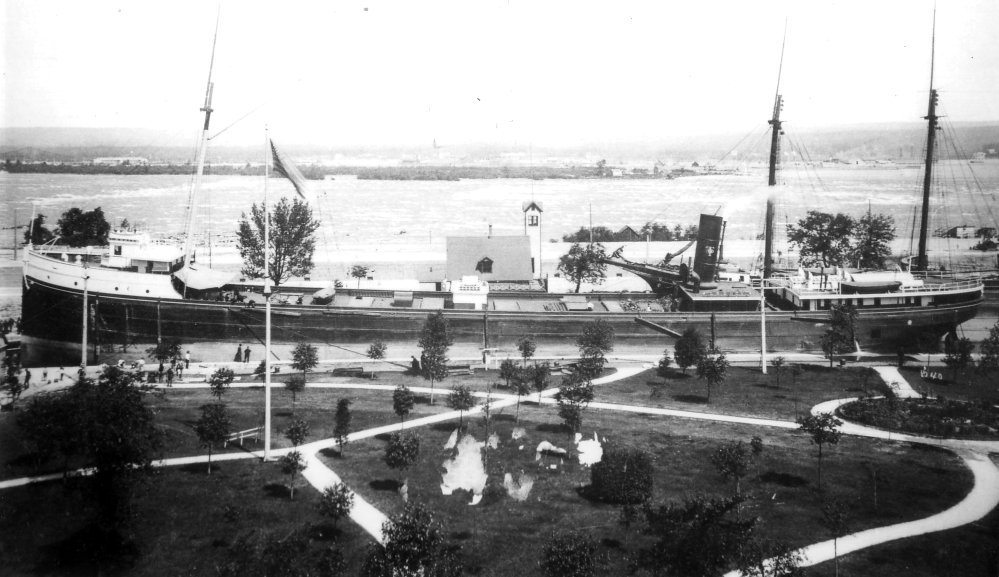
The Doty at the Soo Locks 1896 - Andrew Young photo courtesy of the Historical Collections of the Great Lakes
Steamer L.R. Doty Located in 300 ft of Water off Milwaukee
By Brendon Baillod - brendon@ship-wreck.com
- Copyright © 2010 Great Lakes Shipwreck Research - Please obtain permission
from author before reproducing
| The Ship |
 The Doty at the Soo Locks 1896 - Andrew Young photo courtesy of the Historical Collections of the Great Lakes |
| The Storm | |
| The Discovery | |
| The Discovery Team | |
| Underwater Images |
A group of Wisconsin marine historians and divers have announced the discovery of the missing steamship L.R. Doty, which vanished in a violent Lake Michigan storm 112 years ago, on October 25, 1898. The Doty was the largest wooden ship still missing on Lake Michigan, with an overall length of 300 ft. She was bound from South Chicago to Midland, Ontario with a cargo of corn and the four-masted schooner Olive Jeanette in tow when she was struck by a tremendous storm several miles north of Milwaukee. Waves reportedly reached 30 ft, with 70 mph winds. The Olive Jeanette was severely damaged, but survived the storm. The Doty however, was never seen again. On June 16, 2010 a group of explorers led by marine historian Brendon Baillod and charter captain Jitka Hanakova relocated the site, which had been snagged by a commercial fish tug in 1991, and investigated by local Milwaukee charter captain Jerry Guyer nearly 20 miles off Oak Creek, Wisconsin. Technical divers, including John Janzen, John Scoles, Tracy Xelowski, Jitka Hanakova, Lubo Valuch and Ron Benson descended to the site in over 300 ft of water and filmed the wreck extensively. Marine historians Brendon Baillod and Peter Scotland provided surface support. Video reveals that the ship is upright and intact with the remains of her corn cargo still present in her hold. She is in an amazing state of preservation due to the cold, fresh water and extreme depth.
The L.R. Doty was built in 1893 at West Bay City, Michigan by F.W. Wheeler & Co. for the Cuyahoga Transit Company of Cleveland, Ohio as hull number 97. She was named after Mr. Lucius Ramsey Doty, the general manager of the Cuyahoga Transit Company, and was one of the last of the giant wooden Lake steamers, as steel hulls were quickly replacing wood for large bulk carriers. The Doty was one of six nearly identical sisters, including the steamers William F. Sauber, C.F. Bielman, Tampa, Iosco and Uganda. She was built of white oak with a hull length of 291 ft., a beam of 41 ft. and a depth of 19.8 ft., with a capacity of 2056.34 gross tons. She had nine deck hatches and was built with a tall fore-mast, on which she could set canvas, if necessary. The Doty was built with steel arches embedded in the sides of her hull in order to provide the additional stability necessary for a wooden hull of her size. She was launched in May of 1893 and enrolled at the Cleveland, Ohio customs house on June 5, 1893 where she was awarded official number 141272.
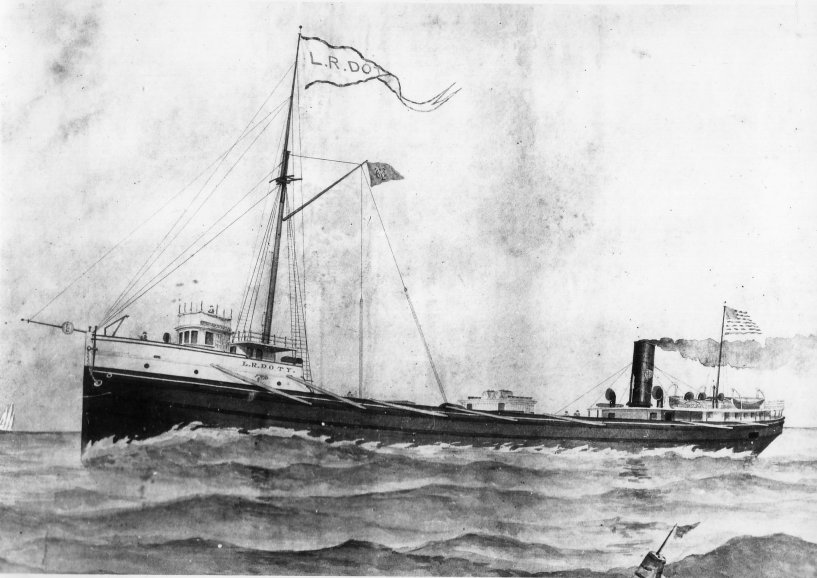
The L.R. Doty from a painting by Rev. Edward J. Dowling courtesy
Historical Collections of the Great Lakes
The Doty was powered by a three cylinder triple-expansion steam engine built by Frontier Iron Works of Detroit, Michigan that could generate 1000 horsepower at 74 rpm, with cylinders of 20, 32.5 and 55 inches, each with a 42 inch stroke. She was fitted with two Scotch boilers of 11.75 x 12 ft. built by Wickes Bros. of Saginaw, Michigan with a steam pressure of 167 psi. The Doty was equipped with a full steam power system for her deck winches, but had neither electric lights nor wireless communications, which would not be common on the Lakes for another 10 years.
When her fitting out was completed, the Doty was inspected by the Inland Lloyds who valued her at $125,000 with a hull rating of A1*, the highest rating attainable for a Lake vessel. This qualified the Doty to carry any cargoes on the Lakes, including iron ore, grain and coal. The Doty immediately entered the iron ore and coal trade in 1893 and began making trips from Duluth, Minnesota, Superior, Wisconsin, Marquette, Michigan and Escanaba, Michigan to Cleveland, Ohio with iron ore. In this capacity, she always towed the 242 ft. four-masted schooner barge Olive Jeanette. The pair would carry coal on the upbound trip and iron ore on the downbound trip. When not carrying iron ore, the pair would carry cargoes of grain to various Lake ports.
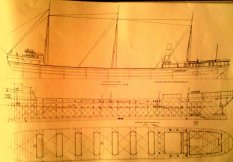 |
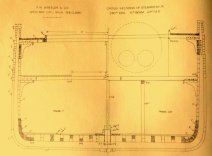 |
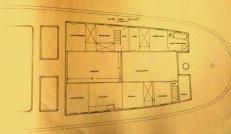 |
The L.R. Doty sailed in a time when weather radar had not yet been invented and forecasting was very primitive. During the Fall, when weather was most treacherous, vessels had the greatest incentive to go out. This was because coal was needed for the winter months and grain from the fall harvests had to be delivered for processing. Consequently, vessels often went out in conditions that were less than ideal. The Doty had successfully weathered many severe Lake storms and had relatively few mishaps for a vessel of her day. She was, by all accounts, a relatively new and sturdy vessel when she sailed out of South Chicago on the afternoon of Monday, October 24, 1898. She was loaded with 107,000 bushels of corn shipped by Counselman & Co. After discharging the corn, the Doty and Jeanette were to proceed to Lake Superior for an iron ore cargo bound for Cleveland.
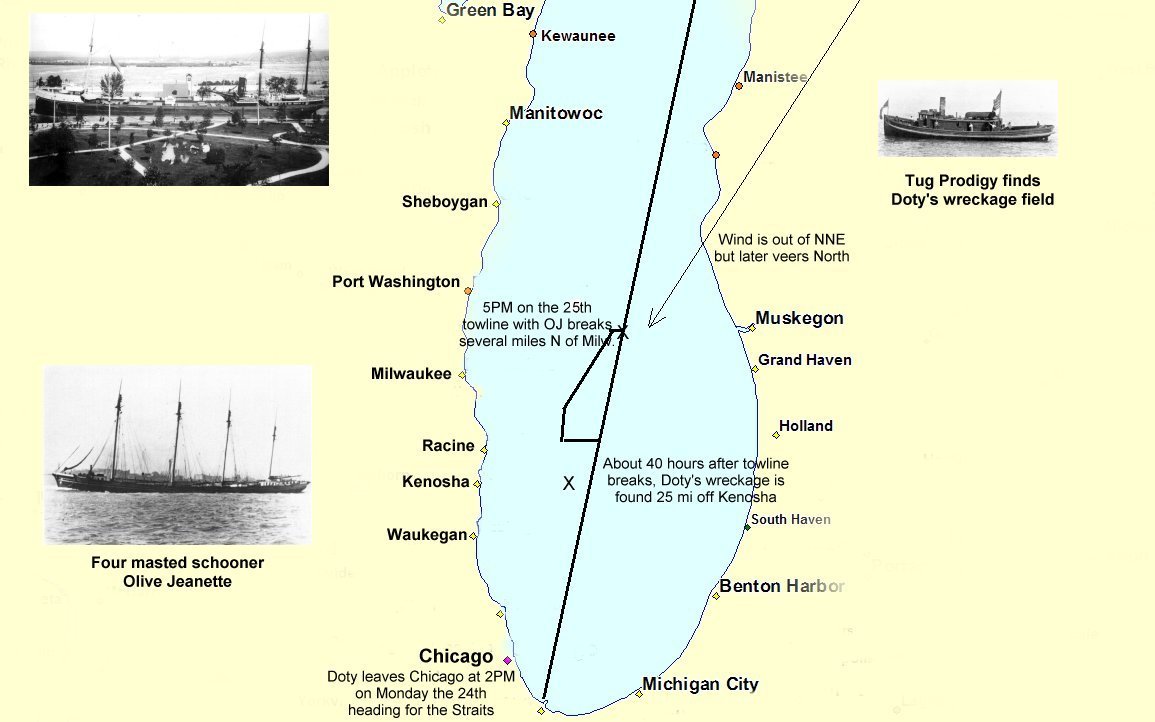
The Doty's course from Fathoms Deep But Not Forgotten:
Wisconsin's Lost Ships by Brendon Baillod
The Doty planned a course that would take her up Lake Michigan toward the Straits of Mackinac, then into Lake Huron and on to Midland, Ontario, where she and the Olive Jeanette would unload their corn cargo. The pair left in fair weather and headed up the Wisconsin shore. About 1 PM on Tuesday, when off Milwaukee, the wind began to pick up out of the northeast and the seas began to build. By 4 PM, snow and sleet began to obscure visibility and the waves had built to over 20 ft. By 5 PM the pair were several miles north of Milwaukee, weathering the storm fairly well, when the towline between the two vessels broke. Captain D.B. Cadotte of the Olive Jeanette reported that the Doty continued to steam off to the north and was soon lost from sight, while the Olive Jeanette crew scrambled to set canvas.
By all accounts the storm of October 1898 was one of the worst in 30 years. At Milwaukee, the schooner Barbarian was driven on the breakwall and destroyed. All across the Lakes, ships were wrecked and many lives were lost. The storm damaged part of the Milwaukee breakwall and destroyed the Chicago boardwalk.
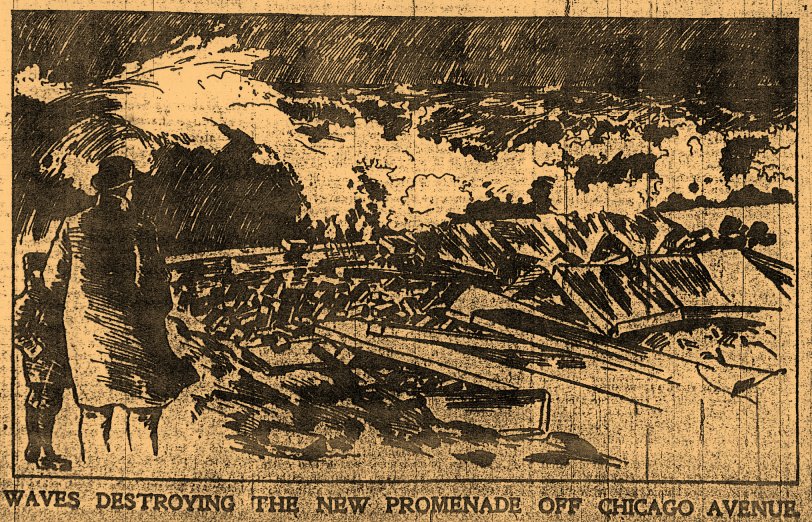 Chicago Tribune - October 26, 1898 |
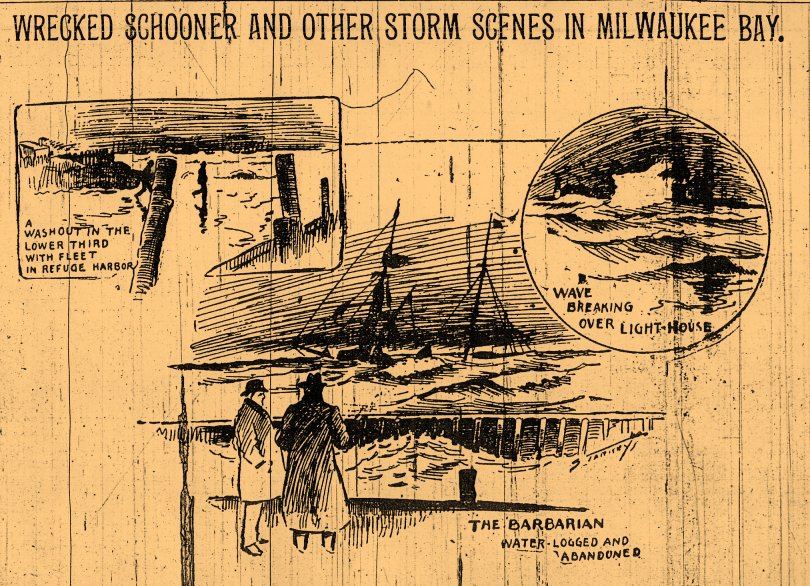 Milwaukee Sentinel - October 26, 1898 |
The Olive Jeanette was to endure one of the most harrowing ordeals in the history of the Lakes before being rescued adrift off Chicago. The crew were without sleep or food for three days while they battled the intense cold and storm. After hours of pounding waves the tattered ship was within site of Racine Harbor when her rudder chains broke and she fell broadside to the waves. The towering seas tore her deckhouses clean off of her decks and washed them overboard. Her topmasts were broken off and her canvas was blown out. The crew survived by lashing themselves to whatever structure remained on deck. She was finally picked up after three days of intense cold and misery adrift off Chicago. She required an extensive rebuild before being put back in service. Sadly, the Olive Jeanette would be lost only seven years later in the great storm of 1905 on Lake Superior. Under tow of the Doty's sister ship, Iosco, she went missing off the Huron Islands. Her battered wreck was located in 300 ft of water, 8 miles off the Huron Islands in the 1990s. The Iosco, however, is still missing.
For a harrowing first person account of the Olive Jeanette's ordeal, click here
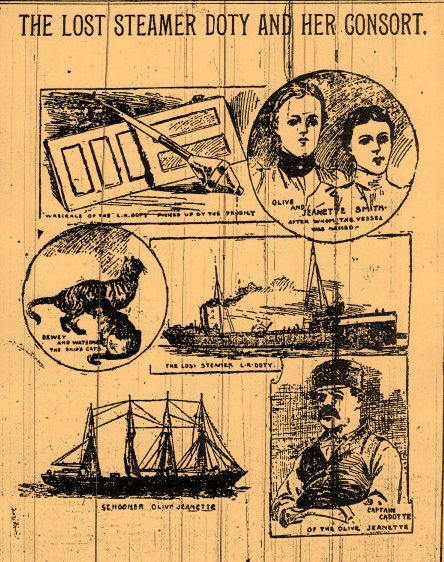 Milwaukee Sentinel - October 29, 1898 |
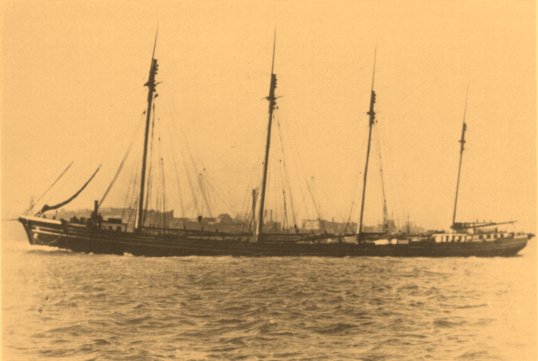 The Olive Jeanette circa 1890 courtesy C. Patrick Labadie Collection, Thunder Bay National Marine Sanctuary |
Nothing was heard of the L.R. Doty's fate until the morning of Thursday the 26th when the tug Prodigy located a floating debris field about 25 miles off Kenosha. The debris consisted of a large amount of wood trim, a stempost, a cabin door, hatch covers and other debris bearing the brown colors of the Doty. Marine men were surprised to learn that the Doty had foundered while her older, less staunch tow had survived. There was a great deal of conjecture in marine circles as to how such a new and sturdy vessel could have foundered. In all, 17 men were lost with the Doty as follows::
Captain Christopher Smith of Port Huron, MI
Henry Sharp, First Mate of Detroit
W.J. Bossie, Second Mate of Detroit
Thomas Abernathie, Engineer of Port Huron
C.W. Odette, Second Engineer
George Wadkin, Oiler
L. Goss, Steward of Bay City, MI
W.J. Scott, Cook
Charles Bornie, Watchman
Peter G. Peterson, Wheelsman
Albert Nelson, Assistant Wheelsman
Joseph Fitzsimmons, Fireman
J. Howe, Deckhand
F. Parmuth, Deckhand
C. Curtis, Deckhand
William Ebert, Deckhand
Pat Ryan, Deckhand
Also lost were the ship's two cats, Dewey and Watson
In the end, marine men concluded that the Doty must have turned to retrieve the Olive Jeanette and suffered a similar fate to her consort (e.g. breaking her rudder chains and falling broadside to the waves). In order to make a turn in the violent storm, the Doty would have needed to make a very wide, gradual turn that would have put her broadside to the waves. In the giant seas, it is possible that the Doty may have parted her rudder chains and been driven broadside to the seas. This would have enabled the seas to tear off her deck houses and potentially breach her hatch covers. In any event, several other vessels were out in the storm between Kenosha and Sheboygan. None saw any evidence of the Doty, although a few sighted the Olive Jeanette. This suggests that the Doty foundered within a few hours of being separated from the Olive Jeanette. The Doty was found with her bow pointed to the northwest, further suggesting that she had fallen broadside to the seas after turning to retrieve the Olive Jeanette.

Images courtesy of C.Patrick Labadie Collection - Thunder
Bay National Marine Sanctuary
Most marine men of the day and most modern books placed the Doty's loss off Kenosha because that is where her floating debris was located. However, a detailed analysis of the Doty's course, the storm direction/duration, the debris scatter and the timelines of the loss was performed by Brendon Baillod in the book Fathoms Deep But Not Forgotten: Wisconsin's Lost Ships. This analysis suggested that the Doty actually foundered somewhere off Milwaukee. This analysis was based on the fact that the Doty was last seen several miles NORTH of Milwaukee and her debris was not located until 40 hours after she was last seen, providing ample time for her debris to drift a considerable distance.
In the final analysis however, the cause and location of the Doty's loss remained a mystery.
In the years that followed the Doty's loss, she faded into history as one of the many thousands of Lake vessels to be wrecked in the 19th century. One turn of the century account in the Racine papers claimed that the Doty had been found off Racine. Unfortunately, the "wreck" turned out to be a previously uncharted part of the Racine Reef. Beginning in the 1960s, interest in locating Great Lakes shipwreck sites was spurred by the advent of scuba diving, and many divers began to search for shipwrecks with remote sensing equipment. Throughout the 1970s, 80s and 90s, occasional rumors of the Doty's discovery surfaced. One rumor had it that the Doty was found in shallow water off Kenosha. However, upon examination, it was proven to be a modern rock barge.
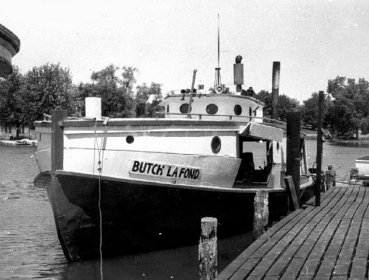
The fish tug Butchie B. as the Butch Lafond - Courtesy of
Harvey Hadland
In August of 1991 the commercial fish tug Butchie B. was gill netting chubs out of Milwaukee and her captain moored her next to the dive boat of Milwaukee charter captain Jerry Guyer, owner of the Pirates Cove Dive Shop and the Milwaukee dive charter boat LenDer. The tug had snagged its nets on a deep obstruction over 20 miles from shore in 300 ft of water and the captain told Guyer about it. Guyer was interested in the site, but had no intention of taking divers to it. In the early 1990s, the technology to safely visit deep wrecks was still not commonplace, and the distance to the site was prohibitive. Guyer made the long trip to the site in the LenDer and imaged it with a fish finder, revealing a large object on the bottom. However, due to depth and distance, the deep snag was relegated to the back burner.
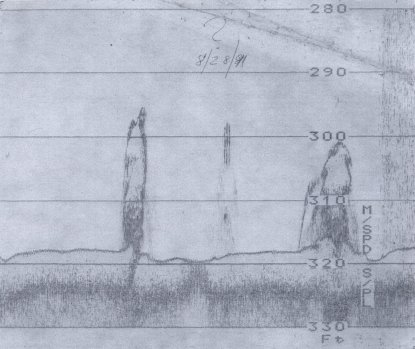 The L.R.Doty in August of 1991 -Courtesy of Jerry Guyer |
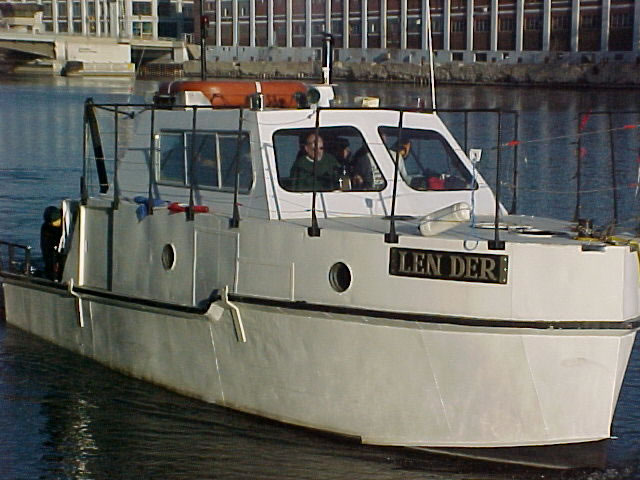 Jerry Guyer's dive charter boat the LenDer - Courtesy of Jerry Guyer |
In the mid 1990s, Wisconsin marine historian Brendon Baillod learned of the deep snag and began to research possible identities for the site. Several significant vessels were lost in deep water south of Milwaukee, including the steamers R.G. Peters, Monitor, Thomas Smith and Lac La Belle. Few people however, were interested in the long boat ride to relocate the site. Relocating the site was also complicated by the fact that the original numbers had been recorded with a LORAN receiver. The LORAN system was set to be decommissioned and LORAN coordinates have an non-standard error when converted to LAT/LON. As such, relocating the site would require some searching far from shore.
Beginning about 2000, technical, mixed gas diving began to gain in popularity among midwest divers. Soon, divers began visiting wrecks in over 200 ft of water safely. Technology to do mixed gas dives with Helium and rebreather technology pushed technical diving well beyond the 400 ft level by 2009. As such, divers began to develop an interest in deep wrecksites. Milwaukee charter captain Jitka Hanakova is one of a new breed of technical diving enthusiasts. She operates the dive boat Mollie V out of Milwaukee through her company Shipwreck Explorers. Over the past five years Jitka has worked with area historians and wreckhunters to visit many deep wrecks. I had worked with Jitka on the wreck of the Robert C. Pringle, found in 2008 off Sheboygan and we had discussed the deep snag off Milwaukee. We decided to make an attempt to locate and identify the site during Milwaukee's Ghost Ships Festival in 2009.
As such, in May of 2010, Jitka relocated the site doing an elaborate search around the area of the 1991 LORAN TDs. She finally found the site and recorded accurate GPS based LAT/LON for it. On June 16, 2010, we had a sufficiently long period of good weather to make the long run back to the site with a team of technical divers. The group departed from McKinley Marina at 8AM and was over the wreck by 10 AM. Captain Jitka did a sonar outline of the wreck, dropping markers on each end. This revealed that the wreck was at least 200 ft long. After carefully hooking the wreck with a grapple, the divers began preparing for the long, cold dive to the wreck.
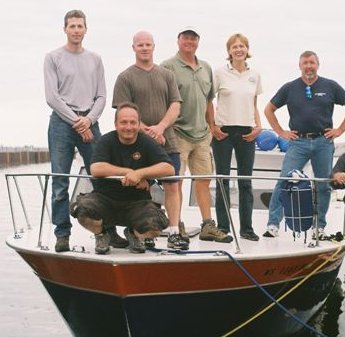
Left to Right: John Janzen, Lubo Valuch, John Scoles, Tracy Xelowski, Jitka
Hanakova, Ron Benson
Photo by Peter Scotland
The first divers down the line were John Janzen, John Scoles and Tracy Xelowski. The three are very experienced technical divers. Janzen and Scoles used rebreather technology that allows them to recycle the gas they exhale. The rebreather chemically scrubs the CO2 out of the exhaled gas and allows them to rebreath it. The rebreather also contains a computer that adjusts and maintains a constant partial pressure of oxygen. Xelowski, a Chicago native, dived the wreck "old school," using double tanks filled with Trimix, a combination of surface air and Helium. The divers had to wear electric heaters in their dry suits to endure the 90 minute hang time to decompress. Some of the divers carried a small tank of Argon, with which they filled their dry-suits in order to prevent the loss of heat.
Approximately 40 minutes into the first dive, as we waited expectantly on the surface, a red lift bag shot to the surface, up the grapple line. The bag contained a note. As none of us expected a message from 300 ft below, we were immediately concerned. Although accidents at extreme depth are uncommon, they are usually fatal. Quickly we grabbed the note and read it. It said....."all divers ok......up in 80 minutes....huge wooden steamship." We immediately knew that we had found the grave of the long lost L.R. Doty.
Xelowski placed a mooring line on the wreck while Janzen and Scoles shot about 40 minutes of hi-def video on the site. After an extended decompression of nearly 90 minutes the divers surfaced. The surface temperature had been about 56 degrees, but the temperature at depth was a chilling 41 degress. Ten years ago, there would have been no ambient light at 300 ft where the Doty lies. However, invasive Quagga mussels that have completely carpeted the wreck have filtered much of the zooplankton from the water, increasing the visibility and the ambient light. At 300 feet, the light is nearly bright enough to film without lights. Visibility on the Doty, however, was only about 40 ft. A very stong surface current was also running at the site.
The second group down included Captain Jitka Hanakova, Lubo Valuch and Ron Benson, who did a complete navigation of the wreck using rebreathers. They were able to examine more detail and to assess the condition of the wreck. Historians Brendon Baillod, a trustee of the Wisconsin Maritime Museum and Peter Scotland from the Wisconsin Marine Historical Society Board remained on the surface providing surface support.
Before leaving the site, Peter Scotland produced a few bottles of Champagne and a toast was drunk to Captain Christopher Smith and the crew of the L.R. Doty. May they rest in peace now that their resting place has been found.
The L.R. Doty is protected by Wisconsin law as a publicly owned historic wrecksite. Salvage from her is prohibited without a permit from the State. However, she will be a popular technical dive target and will begin receiving visitors later this year. Her discovery was reported to the State Historical Society's Maritime Archeology program and the site will likely be surveyed by the State. It may also be nominated to the National Register of Historic Places if it is deemed sufficiently important to our regional history.
The wreck will likely be the subject of a short documentary that will be shown at Milwaukee's Discovery World Museum, the Wisconsin Maritime Museum at Manitowoc and at the Ghost Ships Festival in Milwaukee. For video of the wreck taken by John Janzen, please visit:
http://www.youtube.com/watch?v=Ao1SUtDF_2M
The following images are courtesy of John Scoles. They may not be reproduced without his expressed permission.
A wheel barrow for trimming cargo in the hold has drifted onto the deck |
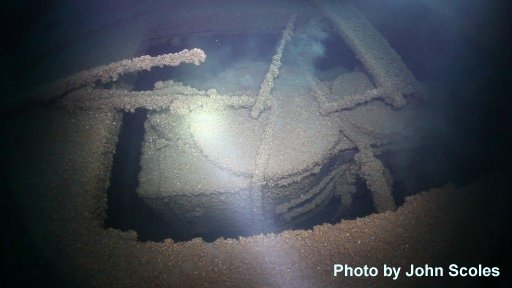 The Doty's triple expansion steam engine |
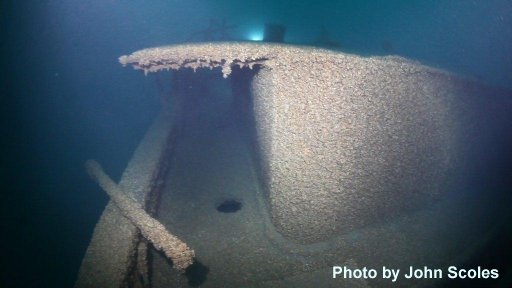 The gangway under the boilerhouse roof |
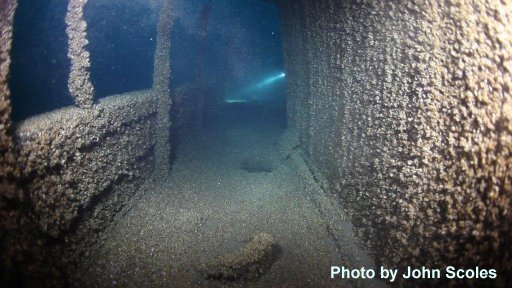 Swimming through the gangway under the boilerhouse |
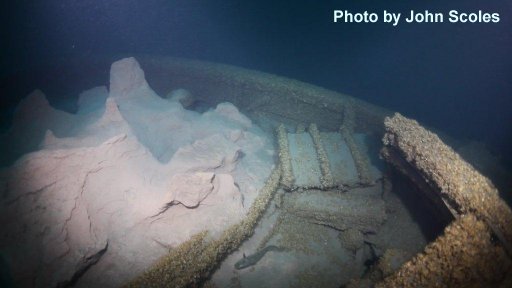 Tons of mud on the stern scooped up when she hit bottom |
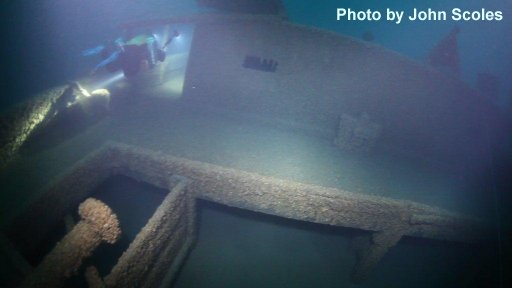 A view inside the hatch just aft of the tool house amidships |
The windlass on the bow |
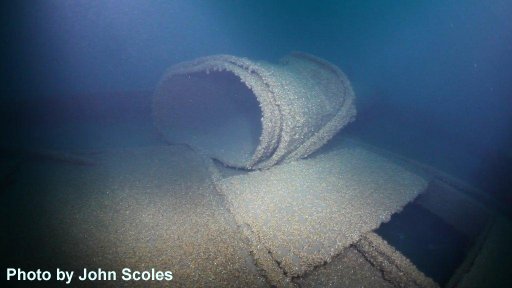 The ship's smokestack toppled on its side |
References:
Baillod, Brendon - Fathoms Deep But Not Forgotten: Wisconsin's Lost Ships
Oleszewski, Wes - Stormy Seas
Herman G. Runge Vessel File - Milwaukee Public Library
Historical Collections of the Great Lakes at Bowling Green State University
Wisconsin Maritime Museum Collections, Manitowoc, Wisconsin
Milwaukee Sentinel October 25, 1898 - October 29, 1898
Chicago Tribune - October 25, 1898 - October 29, 1898
Inland Lloyds Hull Register 1893 - 1898
Certificates of Enrollment for steamer L.R. Doty, Cleveland Customs House -
National Archives
Greenwood, John O. - The Fleet Histories, Vol. 6
Devendorf, John. - Great Lakes Bulk Carriers
Beesons Marine Directory 1888 - 1921
Blue Book of American Shipping 1896 - 1913